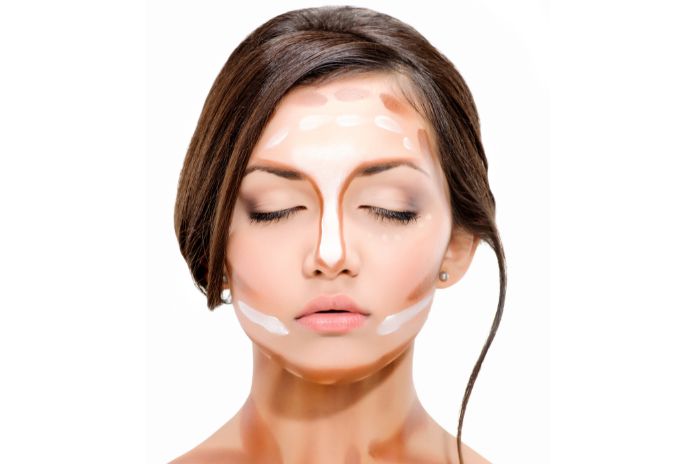When it comes to makeup, foundation is the most important aspect of a makeup routine. It helps to even out skin tone and provide a smooth canvas for the rest of the makeup.
However, with so many types of foundations available in the market, it can be overwhelming to choose the right one. Two of the most popular types of foundations are powder and liquid.
In this article, we will explore the difference between the two and help you make an informed decision on which type of foundation to choose.
Powder foundation is a type of foundation that comes in a powder form. It can be applied with a brush, sponge, or even fingers. It is usually available in loose or pressed form. Powder foundation is lightweight and provides a matte finish. It is a great option for those with oily skin as it helps to absorb excess oil and keep the skin matte.
Powder foundation is great for those with oily skin and those who want a natural, matte finish, while liquid foundation is better for dry or mature skin and those who want more coverage and a dewy finish. The choice between the two depends on personal preference and skin type.
Contents
- 1 What is Liquid Foundation?
- 2 Coverage
- 3 Texture and Consistency
- 4 Finish
- 5 Application
- 6 Skin Type
- 7 Shelf Life
- 8 Convenience
- 9 Cost
- 10 Which One is Better for Acne-Prone Skin?
- 11 Which One is Better for Dry Skin?
- 12 Which One is Better for Oily Skin?
- 13 Which One is Better for Sensitive Skin?
- 14 Conclusion
- 15 FAQs
What is Liquid Foundation?
Liquid foundation is a type of foundation that comes in liquid form. It can be applied with a brush, sponge, or even fingers. Liquid foundation is available in different formulas, such as oil-free, hydrating, and long-wearing. It provides a dewy or matte finish, depending on the formula.
Coverage
Powder foundation provides light to medium coverage. It is great for those who want a natural look and have relatively clear skin. Liquid foundation provides medium to full coverage. It is great for those who want to cover imperfections, such as blemishes, dark spots, and acne scars.
Texture and Consistency
Powder foundation has a dry and powdery texture. It is easy to blend and provides a smooth finish. Liquid foundation has a more liquidy texture. It can be thick or thin, depending on the formula. It takes a bit more effort to blend, but it provides a more flawless finish.
Finish
Powder foundation provides a matte finish. It is great for those who want to reduce shine and oiliness. Liquid foundation provides a dewy or matte finish, depending on the formula. It is great for those who want a more natural look or want to achieve a glowy look.
Application
Powder foundation is easy to apply with a brush, sponge, or even fingers. It is best applied in light layers to avoid a cakey look. Liquid foundation is also easy to apply with a brush, sponge, or even fingers. It is best applied in thin layers and built up to the desired coverage.
Skin Type
Powder foundation is great for those with oily skin as it helps to absorb excess oil and keep the skin matte. It can also work for those with normal or combination skin. Liquid foundation is great for those with dry or mature skin as it provides hydration and a more dewy finish. It can also work for those with normal or combination skin.
Shelf Life
Powder foundation has a longer shelf life than liquid foundation. It can last up to 2 years if stored properly. Liquid foundation has a shorter shelf life and can last up to 1 year if stored properly.
Convenience
Powder foundation is more convenient to use when on the go as it is easy to carry around and does not require any special tools for application. Liquid foundation, on the other hand, can be messy and requires a brush, sponge, or other tools for application. It is not as convenient for travel or touch-ups throughout the day.
Cost
The cost of powder and liquid foundation varies depending on the brand and formula. Generally, powder foundation is less expensive than liquid foundation. However, some high-end brands offer expensive powder foundations, while drugstore brands offer affordable liquid foundations.
Which One is Better for Acne-Prone Skin?
For those with acne-prone skin, liquid foundation is usually a better choice as it provides more coverage and helps to cover blemishes and acne scars. It is important to choose an oil-free formula and make sure it is non-comedogenic to avoid clogging pores. Powder foundation can also work for those with acne-prone skin, but it may not provide enough coverage for severe acne.
Which One is Better for Dry Skin?
For those with dry skin, liquid foundation is usually a better choice as it provides hydration and helps to give a dewy finish. It is important to choose a hydrating formula that contains ingredients such as hyaluronic acid or glycerin. Powder foundation can be too drying for those with dry skin and can emphasize dry patches.
Which One is Better for Oily Skin?
For those with oily skin, powder foundation is usually a better choice as it helps to absorb excess oil and keep the skin matte. It is important to choose a formula that is oil-free and contains ingredients such as kaolin clay or silica. Liquid foundation can be too heavy for those with oily skin and can cause the skin to look greasy.
Which One is Better for Sensitive Skin?
For those with sensitive skin, it is important to choose a foundation that is gentle and non-irritating. Both powder and liquid foundation can work for sensitive skin, but it is important to choose a formula that is fragrance-free and does not contain any irritating ingredients such as alcohol or parabens.
Here is a table outlining the differences between powder and liquid foundation:
| Powder Foundation | Liquid Foundation | |
|---|---|---|
| Coverage | Light to medium | Medium to full |
| Texture | Dry and powdery | Liquidy |
| Finish | Matte | Dewy or matte |
| Application | Easy with brush, sponge, or fingers | Easy with brush, sponge, or fingers |
| Skin Type | Oily | Dry or mature |
| Shelf Life | Up to 2 years | Up to 1 year |
| Convenience | Easy to carry and use on the go | Requires tools for application |
| Cost | Generally less expensive | Varies depending on brand and formula |
| Acne-Prone Skin | May not provide enough coverage for severe acne | Provides more coverage and can cover blemishes and acne scars |
| Dry Skin | Too drying and can emphasize dry patches | Provides hydration and a dewy finish |
| Oily Skin | Helps to absorb excess oil and keep the skin matte | Can be too heavy and cause the skin to look greasy |
| Sensitive Skin | Can work, but choose a fragrance-free and non-irritating formula | Can work, but choose a fragrance-free and non-irritating formula |
Conclusion
In conclusion, the choice between powder and liquid foundation depends on personal preference and skin type. Powder foundation is great for those with oily skin and those who want a natural, matte finish.
Liquid foundation is great for those with dry or mature skin and those who want more coverage and a dewy finish. It is important to choose a formula that is suitable for your skin type and provides the desired coverage and finish.
FAQs
Can you mix powder and liquid foundation together?
Yes, you can mix powder and liquid foundation together to create a custom formula that provides the desired coverage and finish.
Can powder foundation be used as a setting powder?
Yes, powder foundation can be used as a setting powder to help set liquid foundation and provide additional coverage.
How often should you replace your foundation?
It is recommended to replace your foundation every 6-12 months to ensure the formula is still effective and has not expired.
Is liquid foundation better for mature skin?
Yes, liquid foundation is better for mature skin as it provides hydration and helps to give a more youthful, dewy finish.
Can powder foundation cause breakouts?
Powder foundation can cause breakouts if it is not removed properly and can clog pores. It is important to make sure the formula is non-comedogenic and to remove the foundation thoroughly with a gentle cleanser.

